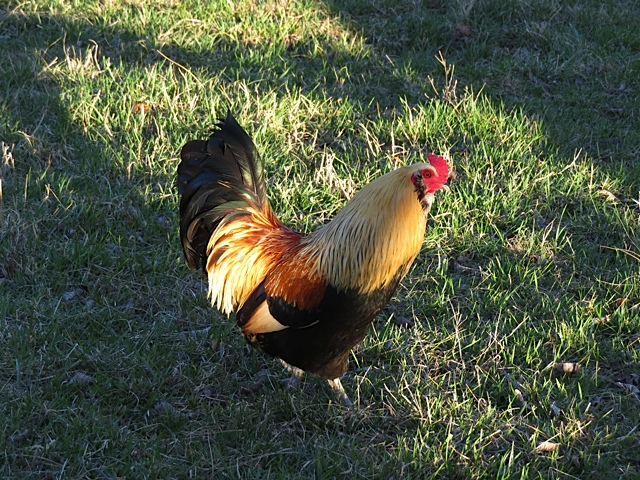There is a constant battle going on between residents of Farmcolony and resident foxes over our chickens. We want chickens to provide us with eggs. Foxes want chicken for dinner. Many of us still fondly recall our favorite rooster, Goliath, who lost his life trying to protect his flock in a predator attack. Yes, we also missed the laying hens we lost in the attack, although they were easily replaced. A good rooster is harder to find.
What should we do when a nuisance animal like a fox threatens our chickens? Shoot it on sight? That’s what happened to a fox on the farm the other day when it was spotted getting too close to the coop. It was shot and killed on sight. True, the fox could easily have been on his way to our chicken coop to kill, maim, but mostly to eat, our chickens, so shooting him on sight was justified to protect our flock, right? Not necessarily.
Foxes are territorial animals, and the size of their territory is related to food availability. When one fox is killed other foxes from outside the area will move in to take over the freed food supply. More foxes are drawn into the opened territory than lived there before and can lead to an actual increase in the overall fox population. Also, foxes can and do control their own numbers by their breeding patterns. The female fox can increase her litter size in response to culling and the dead fox is soon replaced. Hugh Kolb, author of Country Foxes, claims that mathematical models show that, to make a reduction in the number of foxes, you would need to kill over 75% of the current population.
The science is clear; killing foxes on sight does not control the fox population, but it does cause pain and suffering to the fox family. Foxes breed in winter and kits are born in early to midspring. Mid-March is the peak time for births. Baby fox (kits, pups, or cubs) are suckled for the first four weeks, then progressively weaned until seven weeks old. The female (vixen) stays in the den, protecting the offspring until they are weaned and relies on the male (dog fox) to bring her food. If he hasn’t returned with food within three or four hours, then a tragedy has occurred.
Both parents care for their young through the summer before they are able to strike out on their own in the fall. Cubs start to forage for themselves in July. They tend to go for easy-to-catch prey such as insects and earthworms while slowly developing their hunting skills. Thereafter, they compete with adults for food, who may push them off a kill. From late September, the family group breaks up and some or all of the cubs disperse.
The majority of foxes live mainly on a diet of rabbit. The next largest food source is birds, 10-25%, followed by small mammals 7-11%, large mammals 5-9%, with the remainder being taken up by insects, earthworms and fruit. They are opportunistic feeders, meaning they eat pretty much whatever comes along: Mice, rats, squirrels, rabbits and birds, as well as eggs, insects, fruit and carrion, and, yes, chickens, which are
small enough to be easy prey for a wide variety of critters. Fox aren’t the only predators to attack our chickens. Raccoons and hawks are two other culprits.
Overall, farmers benefit from the presence of foxes. Rabbits are considered an agricultural pest. They eat crop plants, including grass. Cows love grass, so we love grass. By eating rabbits, the adult fox population provides an indirect economic benefit to us all. Foxes also help farmers by eating lots of mice and rats. In some areas where foxes had been killed off, rodents increased so much that farmers brought in other foxes.
Shooting a fox on sight in the common areas of the farm does not control the fox population. It does put residents at risk when guns are fired in an area where we live, work and play, a practice which may or may not follow state and local gun laws regarding a discharge of a weapon near buildings and public spaces or Farmcolony rules regarding the use of weapons on Farmcolony land which states, “Any discharge of firearms, crossbows or other projectiles will be strictly controlled for the protection of the population. A single exception is that of an emergency situation such as the “cornering” of a groundhog.”
Farmcolony is designated a wildlife sanctuary, a haven where wild animals and their habitats are protected from any sort of disturbance. “The capturing, killing and poaching of animals is strictly prohibited in these regions,” says one biology textbook. Shooting on sight does not meet the standards of wildlife protection in a wildlife sanctuary. This protection extends not only to fox, but also to all animals living in the common areas of the farm, including snakes. Protections for nuisance animals in areas immediately surrounding our homes fall under different guidelines.
What should you do if you encounter a fox or other wild animal on the farm? Experts say to create a ruckus, but do not approach or chase the animal. Yell, clap your hands, wave your arms, stomp your feet—make your presence known. Loud noises should scare the animal away.
What can we do to protect our chicken flock while also protecting predators? According to experts, the most efficient method of protecting our flock from fox and other predators is to continue to improve the security of the coop, an effort on which the chicken committee spends much time and thought and can boast many successes.
It is scientifically proven that killing a fox does not eliminate a nuisance. More fox will quickly move in to replace the dead fox and may actually result in a higher fox population on the farm. Killing a fox produces suffering in the wildlife world when a mother or father fox is removed from the raising of its kits and the benefit of having foxes on the farm outweighs any losses caused by them. Finally, discharging a weapon in areas where we live, work and play is unadvisable. In short, for the reasons mentioned, shooting and killing a fox on the farm is not justifiable.


